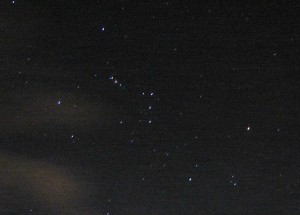 With the lengthening nights, we have the opportunity to find constellations day and night this month. Just before sunrise, in the southwest sky, the constellation Orion, The Hunter, can be seen. It is easy to spot, as it has the three stars in a slightly diagonal line close together making Orion’s belt in the middle. The triangle on top has the bright red star Betelgeuse, on the left. Betelgeuse has nothing to do with beetles or juice! It is an Arabic word, connected to a story about a princess. The star we see on the bottom right side of Orion is the blue star, Rigel.
With the lengthening nights, we have the opportunity to find constellations day and night this month. Just before sunrise, in the southwest sky, the constellation Orion, The Hunter, can be seen. It is easy to spot, as it has the three stars in a slightly diagonal line close together making Orion’s belt in the middle. The triangle on top has the bright red star Betelgeuse, on the left. Betelgeuse has nothing to do with beetles or juice! It is an Arabic word, connected to a story about a princess. The star we see on the bottom right side of Orion is the blue star, Rigel.
I saw this constellation from my window early one morning before sunrise. It is opposite from the sunrise in the east. The sky opposite from where the sun has been or will be is always the darkest, and constellations there are easier to see. Sirius, a star to the left of Orion and slightly lower, is the brightest star in our sky. It is also the closest at only about 9 light years away. Other stars are hundreds or thousands of light years away. Sirius is part of the constellation Canis Major, Orion’s dog.
The full moon will be on November 21. Find more descriptions of the highlights of the night sky at amazing-space.stsci.edu, hilaroad.com and by looking up The Old Farmers Almanac. Happy Stargazing!

